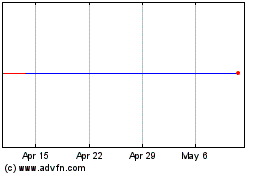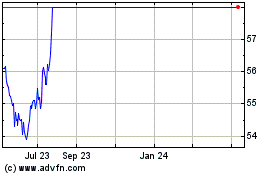Missile Contracts Lift Lockheed -- WSJ
July 24 2019 - 3:02AM
Dow Jones News
By Doug Cameron
This article is being republished as part of our daily
reproduction of WSJ.com articles that also appeared in the U.S.
print edition of The Wall Street Journal (July 24, 2019).
Lockheed Martin Corp. said its sales and profit got a boost from
stepped-up Pentagon spending on hypersonic missiles, with
production slated to start in two years if the advanced weapons
prove workable.
Lockheed has won the largest share of new U.S. hypersonics
contracts, and the world's largest defense company by revenue
expects to book $600 million in sales this year on its prototype
missiles, which can travel more than five times the speed of
sound.
The Pentagon has identified hypersonic missiles -- capable of
striking any target on the planet in as little as 15 minutes -- and
systems to defend against them as one of its highest priorities,
citing development of similar technology by China and Russia.
"That's an area we've been investing in for a number of years,"
Lockheed Chief Executive Marillyn Hewson told analysts Tuesday
after the company reported forecast-beating quarterly profit and
raised its full-year financial guidance. She said Lockheed would
have more than $3.5 billion in hypersonics contracts by the end of
the year.
The segment remains small relative to a record company backlog
of $137 billion, but analysts at Credit Suisse estimate hypersonics
could be worth $35 billion to the industry over the next 20 years,
with Lockheed and rivals Raytheon Co., Northrop Grumman Corp. and
Aerojet Rocketdyne Holdings Inc. all chasing Pentagon work in the
area.
Lockheed expects test flights of its prototype missiles to be
conducted next year, with potential production in the early
2020s.
The company is also benefiting from higher sales of more
conventional missiles to the U.S. and allies, notably in the Middle
East, as well as higher production of the F-35 stealth fighter, the
world's largest military program. Lockheed expects to book the
Pentagon's richest-ever contract -- a $34 billion deal for 438 of
the jets -- in the third quarter.
Ms. Hewson said Lockheed would be compensated for any costs
incurred by the U.S. administration's decision to eject Turkey from
the F-35 program because of the country's purchase of a
Russian-made missile defense system.
The F-35 and hypersonic systems will be competing for Pentagon
dollars under a new U.S. budget deal. The White House and Congress
agreed late Monday on a proposal that would lift the national debt
ceiling and end the threat of automatic spending cuts.
The pact should clear the way for lawmakers to finalize a fiscal
2020 defense budget that would boost spending by around 3% over
2019 levels. However, the 2021 budget could be lower in real terms,
and defense stocks were weak Tuesday. Lockheed was off slightly in
afternoon trading.
Lockheed, which is based in Bethesda, Md., reported a
second-quarter profit of $1.42 billion, compared with $1.16 billion
a year earlier. Earnings per share rose to $5 from $4.05, well
above the $4.77 consensus among analysts polled by FactSet. Sales
rose 7.7% to $14.43 billion.
The company lifted the midpoint of its guidance for 2019
per-share profit by 4% to a range of $20.85 to $21.15, with sales
and free cash flow also guided higher for the full year.
Write to Doug Cameron at doug.cameron@wsj.com
(END) Dow Jones Newswires
July 24, 2019 02:47 ET (06:47 GMT)
Copyright (c) 2019 Dow Jones & Company, Inc.
Aerojet Rocketdyne (NYSE:AJRD)
Historical Stock Chart
From Mar 2024 to Apr 2024

Aerojet Rocketdyne (NYSE:AJRD)
Historical Stock Chart
From Apr 2023 to Apr 2024
